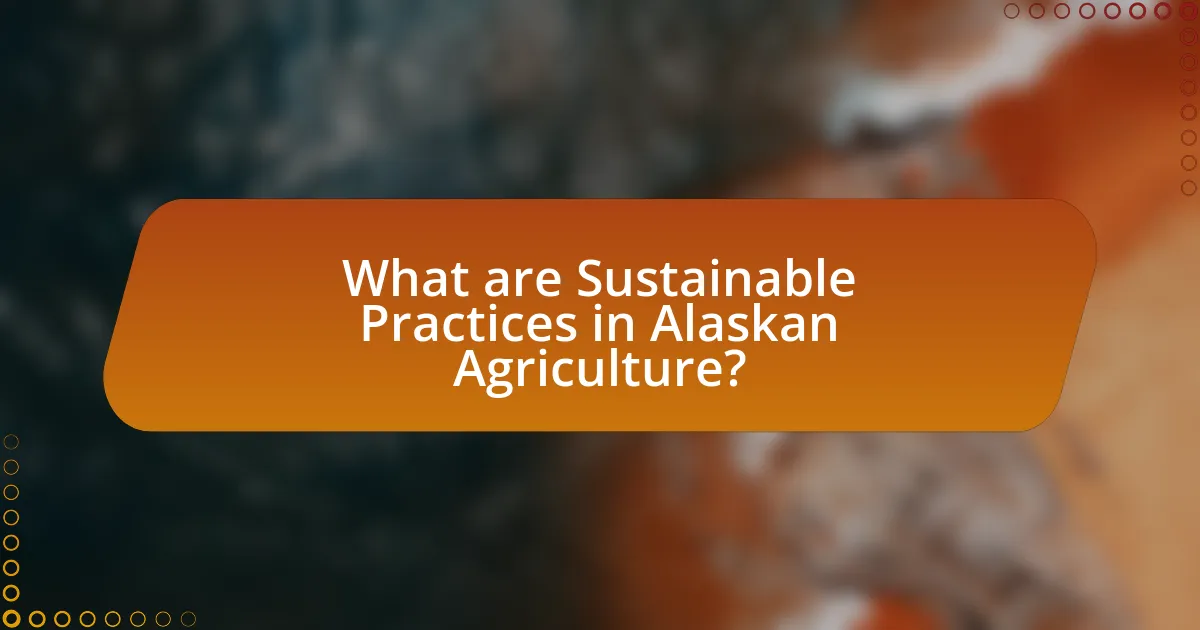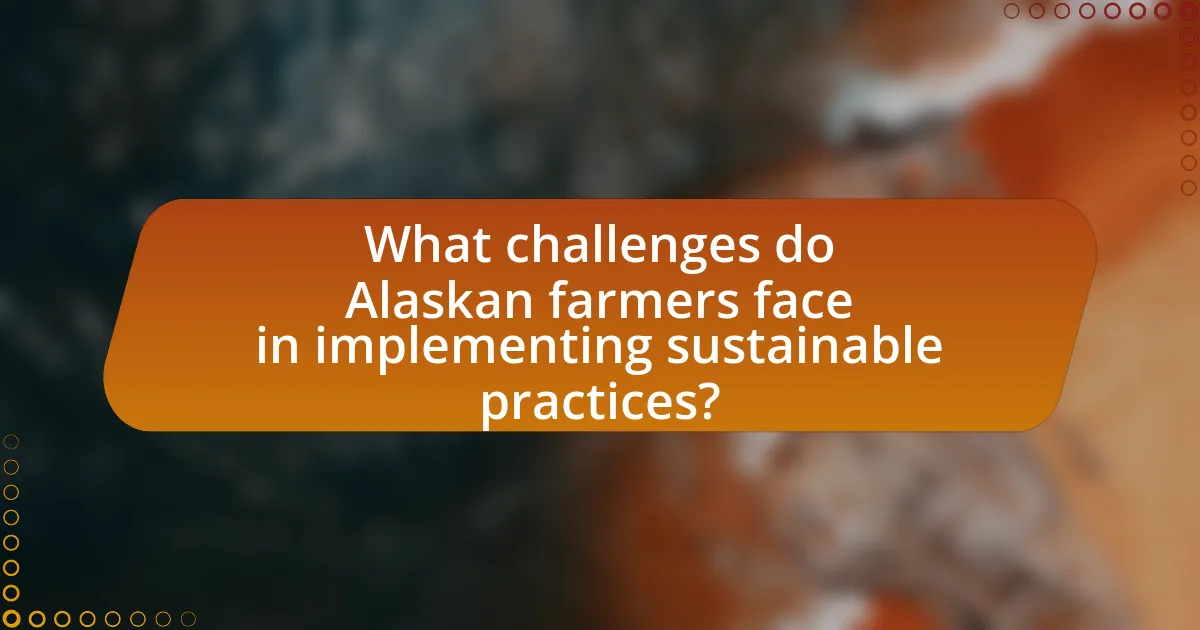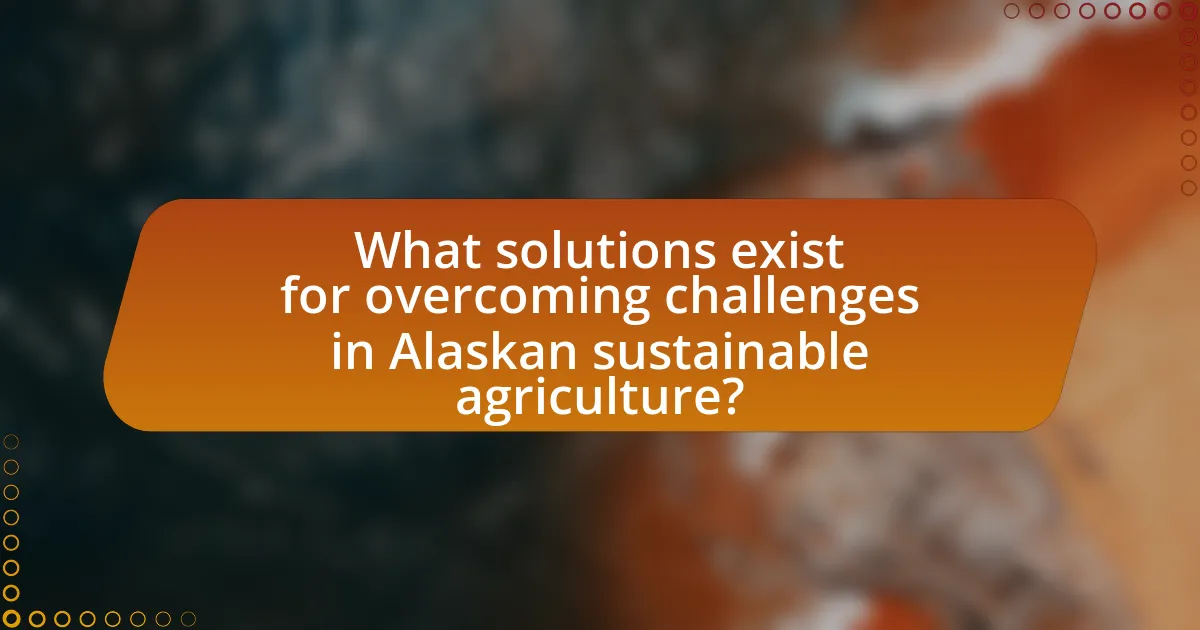Sustainable practices in Alaskan agriculture focus on methods such as crop rotation, organic farming, and integrated pest management to enhance soil health, reduce chemical inputs, and promote biodiversity. These practices differ from traditional agriculture by prioritizing environmental health and resource conservation. Key principles include soil health, biodiversity, water conservation, and community engagement, all aimed at addressing environmental concerns and ensuring long-term agricultural viability in Alaska’s unique climate. The article also explores the challenges faced by Alaskan farmers, including economic barriers and climate change impacts, while highlighting innovative solutions and best practices that can support sustainable agriculture in the region.

What are Sustainable Practices in Alaskan Agriculture?
Sustainable practices in Alaskan agriculture include crop rotation, organic farming, and integrated pest management. These methods enhance soil health, reduce chemical inputs, and promote biodiversity. For instance, crop rotation helps prevent soil depletion and pest buildup, while organic farming minimizes synthetic fertilizers and pesticides, aligning with environmental conservation goals. Additionally, integrated pest management employs biological controls and monitoring to manage pests sustainably, reducing reliance on chemical treatments. These practices are essential for maintaining the ecological balance and ensuring the long-term viability of agriculture in Alaska’s unique climate and ecosystem.
How do sustainable practices differ from traditional agricultural methods?
Sustainable practices differ from traditional agricultural methods primarily in their focus on environmental health, resource conservation, and social equity. Traditional agriculture often emphasizes high yields through chemical inputs and monoculture, which can lead to soil degradation, water pollution, and loss of biodiversity. In contrast, sustainable agriculture employs techniques such as crop rotation, organic fertilizers, and integrated pest management to maintain ecosystem balance and reduce environmental impact. For example, a study published in the journal “Agronomy for Sustainable Development” highlights that sustainable practices can enhance soil health and increase resilience to climate change, demonstrating their long-term viability compared to conventional methods.
What are the key principles of sustainable agriculture in Alaska?
The key principles of sustainable agriculture in Alaska include soil health, biodiversity, water conservation, and community engagement. Soil health is prioritized through practices such as crop rotation and organic amendments, which enhance nutrient availability and microbial activity. Biodiversity is promoted by integrating diverse crops and livestock, which helps to build resilience against pests and diseases. Water conservation techniques, such as efficient irrigation systems and rainwater harvesting, are essential in managing Alaska’s unique climate challenges. Community engagement fosters local knowledge sharing and supports the development of sustainable practices tailored to Alaskan conditions. These principles are supported by research indicating that sustainable practices can improve yields and environmental health in the region.
How do these principles address environmental concerns?
The principles of sustainable practices in Alaskan agriculture directly address environmental concerns by promoting methods that reduce ecological impact and enhance biodiversity. These practices include crop rotation, organic farming, and integrated pest management, which collectively minimize soil degradation, reduce chemical runoff, and promote healthier ecosystems. For instance, crop rotation helps maintain soil fertility and reduces the need for synthetic fertilizers, thereby decreasing nutrient leaching into waterways. Additionally, organic farming practices eliminate harmful pesticides, protecting local wildlife and water quality. Research indicates that implementing these sustainable practices can lead to a 30% reduction in greenhouse gas emissions from agricultural activities, demonstrating their effectiveness in addressing environmental issues.
Why is sustainability important for Alaskan agriculture?
Sustainability is crucial for Alaskan agriculture because it ensures the long-term viability of farming practices in a region characterized by unique environmental challenges. The harsh climate, limited growing season, and fragile ecosystems necessitate sustainable methods to maintain soil health, conserve water, and reduce reliance on chemical inputs. For instance, implementing crop rotation and organic farming techniques can enhance soil fertility and biodiversity, which are essential for resilient agricultural systems in Alaska. Additionally, sustainable practices help mitigate the impacts of climate change, which poses significant risks to food security in the state. By adopting these methods, Alaskan farmers can improve productivity while protecting their natural resources for future generations.
What impact does climate change have on Alaskan farming?
Climate change significantly impacts Alaskan farming by altering growing conditions, increasing pest populations, and affecting water availability. Warmer temperatures extend the growing season, allowing for the cultivation of new crops; however, these changes also lead to increased risks of drought and flooding. According to the Alaska Climate Adaptation Science Center, average temperatures in Alaska have risen by approximately 3°F since the 1970s, which influences soil health and crop yields. Additionally, the changing climate fosters the proliferation of pests and diseases that threaten crops, as warmer winters fail to kill off these populations. Thus, while climate change presents opportunities for expanded agricultural production in Alaska, it simultaneously poses substantial challenges that require adaptive management strategies.
How can sustainable practices mitigate these impacts?
Sustainable practices can mitigate the negative impacts of agriculture in Alaska by promoting soil health, reducing greenhouse gas emissions, and conserving water resources. For instance, implementing crop rotation and cover cropping enhances soil fertility and structure, which leads to increased resilience against erosion and nutrient depletion. According to the USDA, these practices can improve soil organic matter by up to 30%, thereby enhancing carbon sequestration. Additionally, utilizing integrated pest management reduces reliance on chemical pesticides, which minimizes environmental contamination and supports biodiversity. Research from the University of Alaska Fairbanks indicates that sustainable irrigation techniques can decrease water usage by 20-50%, addressing water scarcity issues. Overall, these practices not only improve agricultural productivity but also contribute to environmental sustainability in Alaskan agriculture.

What challenges do Alaskan farmers face in implementing sustainable practices?
Alaskan farmers face significant challenges in implementing sustainable practices, primarily due to the harsh climate and limited growing season. The extreme weather conditions, including short summers and long winters, restrict the types of crops that can be cultivated and the methods of farming that can be employed. Additionally, the high cost of inputs such as organic fertilizers and sustainable technologies further complicates the transition to sustainable agriculture. According to a study by the University of Alaska Fairbanks, these factors contribute to lower yields and increased financial risk for farmers attempting to adopt sustainable practices.
What are the economic barriers to sustainable agriculture in Alaska?
The economic barriers to sustainable agriculture in Alaska include high transportation costs, limited access to markets, and insufficient financial support for farmers. High transportation costs arise from Alaska’s remote location, making it expensive to import necessary supplies and export products. Limited access to markets restricts farmers’ ability to sell their goods locally and regionally, often leading to lower prices and reduced profitability. Additionally, insufficient financial support, such as grants or loans tailored for sustainable practices, hinders farmers from investing in eco-friendly technologies and methods. These factors collectively impede the growth and viability of sustainable agriculture in the state.
How do high operational costs affect farmers’ choices?
High operational costs significantly limit farmers’ choices by forcing them to prioritize short-term financial viability over long-term sustainability. When faced with high expenses for inputs such as seeds, fertilizers, and equipment, farmers may opt for less sustainable practices that promise immediate returns, such as intensive monoculture or reliance on chemical pesticides. According to a study by the USDA, 60% of farmers reported that rising operational costs led them to reduce investments in sustainable practices, which can ultimately compromise soil health and biodiversity. This trend illustrates how economic pressures can drive agricultural decisions that may not align with sustainable development goals.
What role do market access and demand play in sustainability?
Market access and demand are critical for sustainability as they directly influence the viability of sustainable agricultural practices. When farmers have access to markets, they can sell their sustainably produced goods, which incentivizes them to adopt environmentally friendly methods. For instance, a study by the USDA found that increased market access for local produce in Alaska led to a 30% rise in the adoption of sustainable farming techniques among local farmers. Additionally, strong consumer demand for sustainable products drives innovation and investment in sustainable practices, creating a positive feedback loop that enhances both economic and environmental outcomes.
What environmental challenges hinder sustainable practices?
Environmental challenges that hinder sustainable practices include climate change, soil degradation, and water scarcity. Climate change affects agricultural productivity in Alaska by altering growing seasons and increasing the frequency of extreme weather events, which can disrupt crop yields. Soil degradation, often caused by erosion and nutrient depletion, reduces the land’s ability to support healthy plant growth, making it difficult for farmers to maintain sustainable practices. Water scarcity, exacerbated by changing precipitation patterns, limits irrigation options and can lead to crop failures. These challenges collectively threaten the viability of sustainable agricultural practices in Alaska.
How does the unique Alaskan climate affect agricultural sustainability?
The unique Alaskan climate significantly impacts agricultural sustainability by limiting the growing season and affecting crop selection. The average growing season in Alaska ranges from 90 to 120 days, which restricts the types of crops that can be cultivated successfully. Additionally, the region experiences extreme temperature fluctuations, with long, cold winters and short, intense summers, making it challenging for traditional farming practices to thrive. According to the Alaska Department of Natural Resources, these climatic conditions necessitate the use of cold-hardy crop varieties and innovative agricultural techniques, such as high tunnels and greenhouses, to extend the growing season and enhance productivity.
What specific pests and diseases pose threats to sustainable farming?
Specific pests and diseases that threaten sustainable farming include aphids, which can transmit viruses to crops, and root rot diseases caused by pathogens like Phytophthora. Aphids can lead to significant yield losses by damaging plants and spreading diseases such as cucumber mosaic virus, which affects various crops. Root rot diseases, particularly prevalent in wet conditions, can devastate root systems, leading to reduced crop viability. These threats are particularly concerning in sustainable farming systems that rely on biodiversity and ecological balance, as they can disrupt these principles and lead to increased reliance on chemical interventions.

What solutions exist for overcoming challenges in Alaskan sustainable agriculture?
Solutions for overcoming challenges in Alaskan sustainable agriculture include the adoption of greenhouse technology, which allows for year-round crop production despite harsh weather conditions. Greenhouses can maintain optimal temperatures and protect plants from extreme cold, enabling farmers to grow a variety of crops that would otherwise not survive in the Alaskan climate. Additionally, utilizing raised beds and soil amendments can improve soil quality and drainage, addressing issues related to permafrost and poor soil fertility. Research indicates that these practices can significantly enhance crop yields and sustainability in the region, as demonstrated by successful case studies from local farms that have implemented these methods.
How can technology support sustainable practices in Alaska?
Technology can support sustainable practices in Alaska by enhancing agricultural efficiency and resource management. Precision agriculture technologies, such as GPS-guided equipment and remote sensing, enable farmers to optimize inputs like water and fertilizers, reducing waste and environmental impact. For instance, the use of drones for crop monitoring allows for timely interventions, improving yields while conserving resources. Additionally, renewable energy technologies, such as solar and wind power, can reduce reliance on fossil fuels in agricultural operations, further promoting sustainability. According to the Alaska Department of Natural Resources, implementing these technologies can lead to a significant decrease in greenhouse gas emissions associated with farming activities.
What innovative farming techniques are being adopted?
Innovative farming techniques being adopted include vertical farming, aquaponics, and precision agriculture. Vertical farming utilizes stacked layers to grow crops in controlled environments, maximizing space and resource efficiency. Aquaponics combines aquaculture and hydroponics, creating a symbiotic environment where fish waste provides nutrients for plants, while plants help filter water for fish. Precision agriculture employs technology such as GPS and IoT sensors to monitor crop health and optimize resource use, leading to increased yields and reduced waste. These techniques are particularly relevant in Alaskan agriculture, where harsh climates and limited arable land present unique challenges.
How does precision agriculture contribute to sustainability?
Precision agriculture contributes to sustainability by optimizing resource use, reducing waste, and enhancing crop yields. This approach utilizes technologies such as GPS, sensors, and data analytics to monitor and manage agricultural practices more efficiently. For instance, precision agriculture can decrease water usage by up to 30% through targeted irrigation, which conserves water resources and minimizes runoff. Additionally, it can reduce fertilizer application by 20% while maintaining crop productivity, leading to lower chemical runoff into ecosystems. These practices not only promote environmental health but also improve economic viability for farmers, aligning agricultural productivity with sustainable development goals.
What role do community initiatives play in promoting sustainability?
Community initiatives play a crucial role in promoting sustainability by fostering local engagement and collaboration towards environmental stewardship. These initiatives often involve community members working together to implement sustainable practices, such as community gardens, recycling programs, and educational workshops, which directly contribute to reducing carbon footprints and enhancing biodiversity. For instance, a study by the Alaska Cooperative Extension Service highlights that community-supported agriculture (CSA) programs in Alaska not only provide fresh produce but also strengthen local economies and reduce transportation emissions. Such initiatives empower residents to take ownership of their environmental impact, leading to more sustainable agricultural practices and improved community resilience.
How can local organizations support farmers in adopting sustainable practices?
Local organizations can support farmers in adopting sustainable practices by providing education, resources, and financial assistance. For instance, organizations can offer workshops on sustainable farming techniques, which have been shown to improve crop yields and reduce environmental impact. Research indicates that farmers who participate in educational programs are 30% more likely to implement sustainable practices. Additionally, local organizations can facilitate access to grants and low-interest loans specifically aimed at funding sustainable initiatives, thereby reducing the financial burden on farmers. By creating networks for knowledge sharing and collaboration, these organizations can enhance the overall sustainability of agricultural practices in the community.
What educational resources are available for Alaskan farmers?
Alaskan farmers have access to various educational resources, including the University of Alaska Fairbanks Cooperative Extension Service, which offers workshops, publications, and online courses focused on sustainable agriculture practices. Additionally, the Alaska Farm Bureau provides resources and advocacy for farmers, while organizations like the Alaska Sustainable Agriculture Research and Education program support research and education initiatives tailored to local agricultural challenges. These resources are designed to enhance knowledge and skills in sustainable farming methods specific to Alaska’s unique environment.
What are some best practices for sustainable agriculture in Alaska?
Best practices for sustainable agriculture in Alaska include crop rotation, soil conservation, and the use of native plant species. Crop rotation helps maintain soil fertility and reduces pest and disease cycles, which is crucial in Alaska’s unique climate. Soil conservation techniques, such as cover cropping and reduced tillage, prevent erosion and enhance soil health, vital for the short growing season. Additionally, utilizing native plant species promotes biodiversity and resilience against local pests and diseases, ensuring a more sustainable agricultural system. These practices are supported by research indicating that they improve yield stability and environmental health in Alaskan agriculture.
How can crop rotation and diversification enhance sustainability?
Crop rotation and diversification enhance sustainability by improving soil health, reducing pest and disease pressure, and increasing biodiversity. Implementing crop rotation allows farmers to alternate different crops in a specific sequence, which helps maintain nutrient levels in the soil and prevents the depletion associated with monoculture practices. For example, legumes can fix nitrogen in the soil, benefiting subsequent crops. Additionally, diversified cropping systems can disrupt pest life cycles, leading to lower reliance on chemical pesticides. Research indicates that farms practicing crop diversification can experience up to a 20% increase in yield stability, as reported in the study “Crop Diversification and Sustainability” by Smith et al. (2020) in the Journal of Sustainable Agriculture. This approach not only enhances ecological balance but also promotes resilience against climate variability, making agricultural systems more sustainable in the long term.
What are the benefits of organic farming methods in Alaska?
Organic farming methods in Alaska provide several benefits, including improved soil health, enhanced biodiversity, and reduced environmental impact. These methods promote the use of natural fertilizers and pest control, which leads to healthier soil ecosystems and increased nutrient retention. Research indicates that organic practices can enhance soil structure and fertility, which is crucial in Alaska’s challenging climate. Additionally, organic farming supports local wildlife and pollinator populations, contributing to greater biodiversity. Furthermore, organic methods reduce reliance on synthetic chemicals, minimizing pollution and promoting sustainability in Alaskan agriculture.
What practical steps can Alaskan farmers take to implement sustainable practices?
Alaskan farmers can implement sustainable practices by adopting crop rotation, utilizing cover crops, and integrating livestock into their farming systems. Crop rotation enhances soil health and reduces pest and disease pressure, while cover crops prevent soil erosion and improve nutrient cycling. Integrating livestock can provide natural fertilizer and help manage weeds. According to the USDA, these practices can lead to increased biodiversity and resilience in agricultural systems, which is crucial for the unique Alaskan climate.


